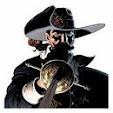In this post we will talk about a daughter of Ferdinand III, half-sister of Alfonso X: Eleanor of Castile.
Eleanor of Castile (1241-1290) married his second cousin and heir to the throne of England, the future Edward I (1239-1307) in the monastery of Las Huelgas, Burgos, in 1254.
The wedding was agreed to make peace between the crowns of Castile and England after a war for possession of Gascony. Eleanor of England had taken this territory as dowry when she married Alfonso VIII of Castile (see Eleanor of England, Queen of Castile).
The marriage of Eleanor and Edward worked very well since the beginning. In 1270, Edward, accompanied by Eleanor, went to the Holy Land to participate in the Eighth Crusade. On his return to England in 1274, they both were crowned together, as Henry III, Edward's father, had died in 1272.
Edward I was a firm king that dominated Wales and fought against France and the Scots. Among other nicknames, he is called "The Hammer of the Scots", but he was defeated at the Battle of Stirling by William Wallace. Unlike other English kings, Edward I is virtually unknown in Spain, although he is the English king who appears in the movie Braveheart.
Edward was not only a warrior, but also a remarkable legislator and a castles builder. The Tower of London had major expansions during his reign. He also expelled the Jews from England in 1290.
Eleanor was always beside her husband. She accompanied him on many of his campaigns, not only in the crusade. She was a well-educated, intelligent and very active woman, but with limited political influence. In fact she had no impact on the political history of Edward’s reign.
She gave birth to 15 children, of which only a few reached adulthood. Her last son, born in Wales, was Edward II.
Eleanor died in 1290 during a trip to the north of England, in Harby, Lincolnshire. Edward was broken by pain. Her body was transported with great pomp to Westminster Abbey where she is buried today.
At the twelve resting-places of the funeral bier, Edward ordered to erect monuments, each one displaying images of the Queen. There still exist three of these monuments, known as Eleanor Crosses. Outside Charing Cross station in London, there is a replica of one of those crosses, built in the nineteenth century.
It is also said that Elephant & Castle, the strange name of another tube station, is an English corruption of the words Infanta of Castile.
La Edad Media en Murcia. El dominio cristiano, contamos que en el año 1244, el hijo del rey Fernando III el Santo, heredero al trono de Castilla y León, el futuro Alfonso X el Sabio, ocupó la región de Murcia, hasta entonces bajo dominio musulmán.
En esta entrada vamos a hablar de una hija de Fernando III, hermanastra de Alfonso X: Leonor de Castilla.
Leonor de Castilla (1241-1290) se casó con su primo segundo y heredero al trono de Inglaterra, el futuro Eduardo I (1239-1307) en el monasterio de Las Huelgas, Burgos, en 1254.
La boda se acordó para sellar la paz entre las coronas de Castilla e Inglaterra tras una guerra por la posesión de Gascuña. Leonor de Inglaterra había llevado este territorio como dote al casarse con Alfonso VIII de Castilla (ver Leonor de Inglaterra, reina de Castilla).
El matrimonio de Eleonor y Eduardo fue bien desde el principio. En 1270, Eduardo, acompañado por Leonor, se fue a Tierra Santa a participar en la octava cruzada. A su regreso a Inglaterra en 1274, fueron coronados juntos, pues Enrique III, padre de Eduardo, había muerto en 1272.
Eduardo I fue un rey enérgico que sometió a Gales y combatió a Francia y a los escoceses. Entre otros sobrenombres, se le conoce como “el martillo de los escoceses”, aunque fue derrotado en la batalla de Stirling por William Wallace. A diferencia de otros reyes ingleses, Eduardo I es prácticamente desconocido en España, aunque es precisamente el rey inglés que aparece en la película Braveheart.
Eduardo no fue sólo un guerrero, sino también un notable legislador y constructor de castillos. La Torre de Londres tuvo importantes ampliaciones durante su reinado. También expulsó a los judíos de Inglaterra en 1290.
Leonor siempre estuvo al lado de su marido. Además de a las cruzadas, le acompañó en muchas de sus campañas. Fue una mujer culta, inteligente y muy activa, pero con limitada influencia política. De hecho no tuvo ningún impacto en la historia política del reinado de Eduardo.
Dio a luz a 15 hijos, de los que pocos alcanzaron la edad adulta. El menor, nacido en Gales, fue Eduardo II.
Leonor falleció en 1290 durante un viaje al norte de Inglaterra, en Harby, Lincolnshire. Eduardo quedó roto por el dolor. El cuerpo fue trasladado con gran pompa a la abadía de Westminster donde sigue enterrada en la actualidad.
En los doce lugares en los que el cortejo fúnebre descansó, Eduardo ordenó erigir monumentos con imágenes de la reina y rematados con una cruz, Aún se conservan tres de estos monumentos, conocidos como Cruces de Leonor. En el exterior de la estación del metro de Londres de Charing Cross hay una réplica de una de esas cruces, construida en el siglo XIX.
También se dice que Elephant & Castle, el extraño nombre de otra estación de metro, es una corrupción inglesa de las palabras Infanta of Castile.
Bibliography and links / Bibliografía y enlaces
The really useful guide to Kings and Queens of England. Historic Royal Palaces. 2011Victoria and Albert Museum. London
Leonor de Castilla (1241-1290) Wikipedia (Español)
Eleanor of Castile (1241-1290) Wikipedia (English)
Leonor de Inglaterra, Reina de Castilla / Eleanor of England, Queen of Castile (1162-1214)
The Middle Ages in Murcia. The Christian rule
La Edad Media en Murcia. El dominio cristiano
 |
| Top of the Eleanor Cross at Charing Cross / Remate de la Cruz de Leonor en Charing Cross |












No hay comentarios:
Publicar un comentario